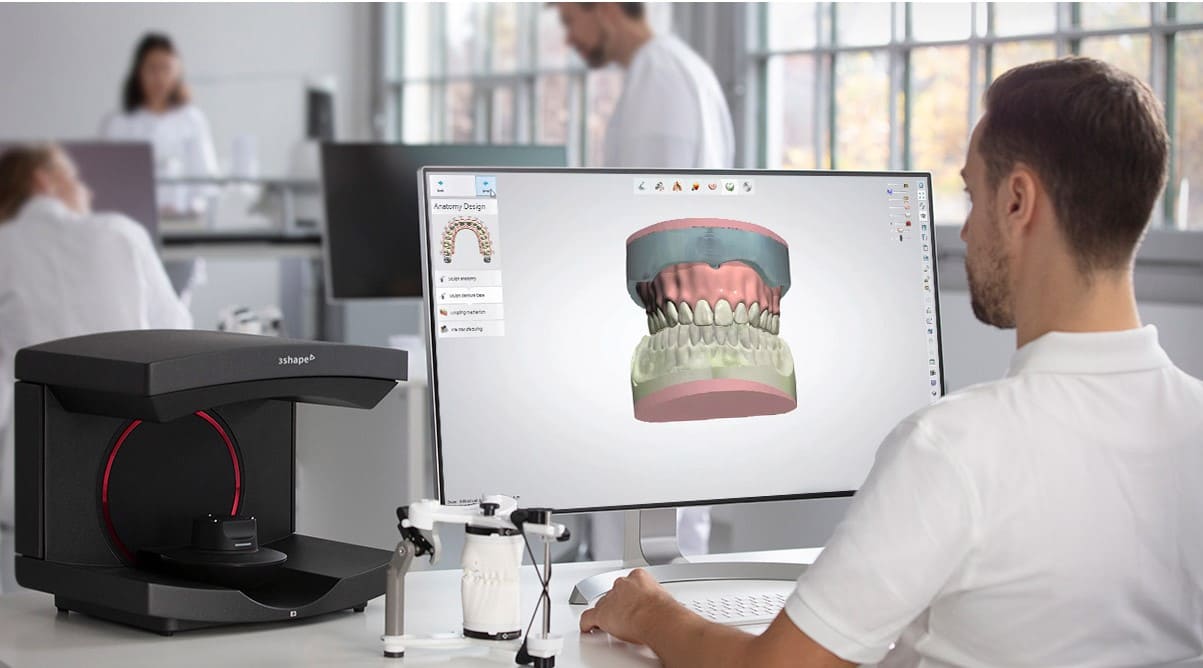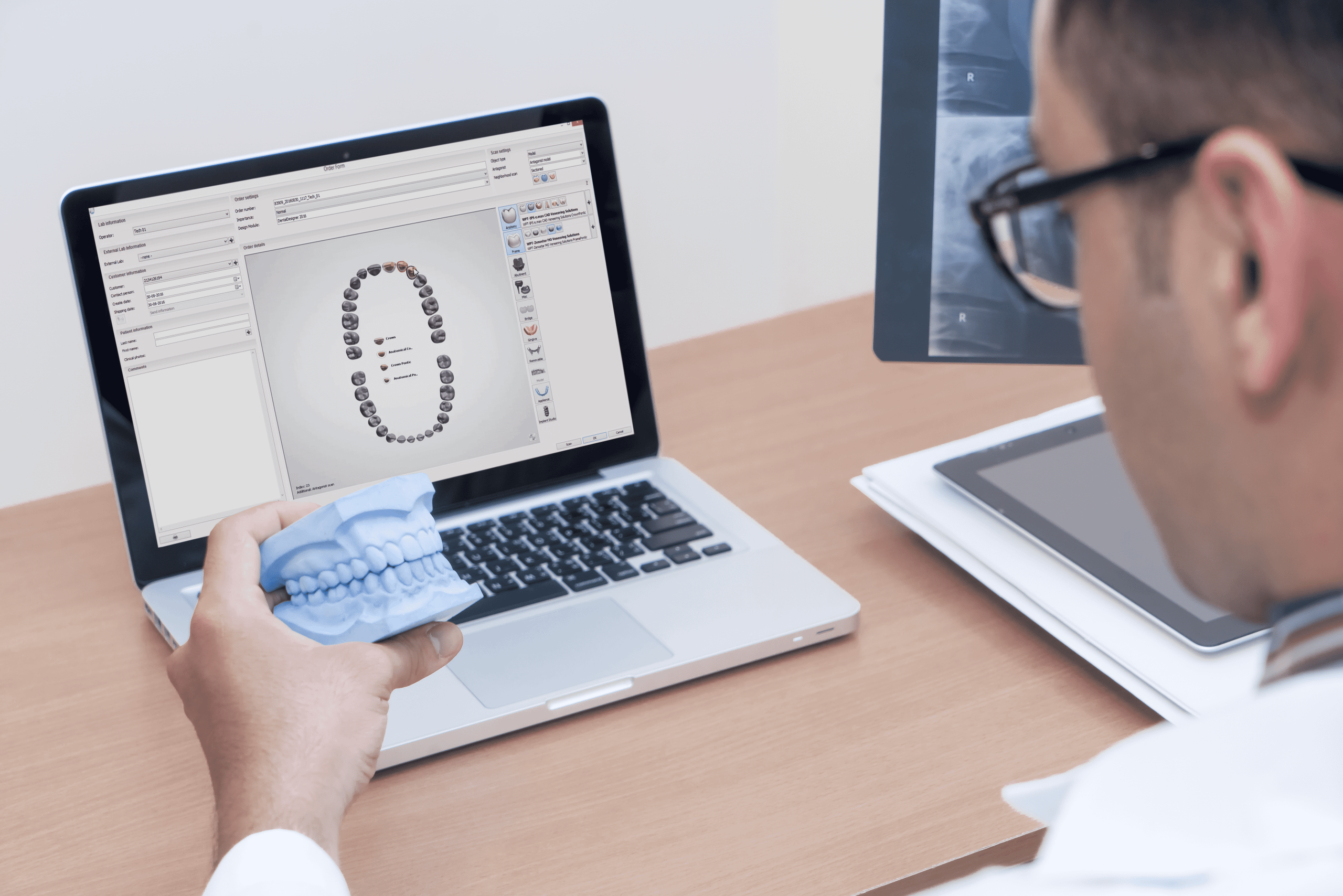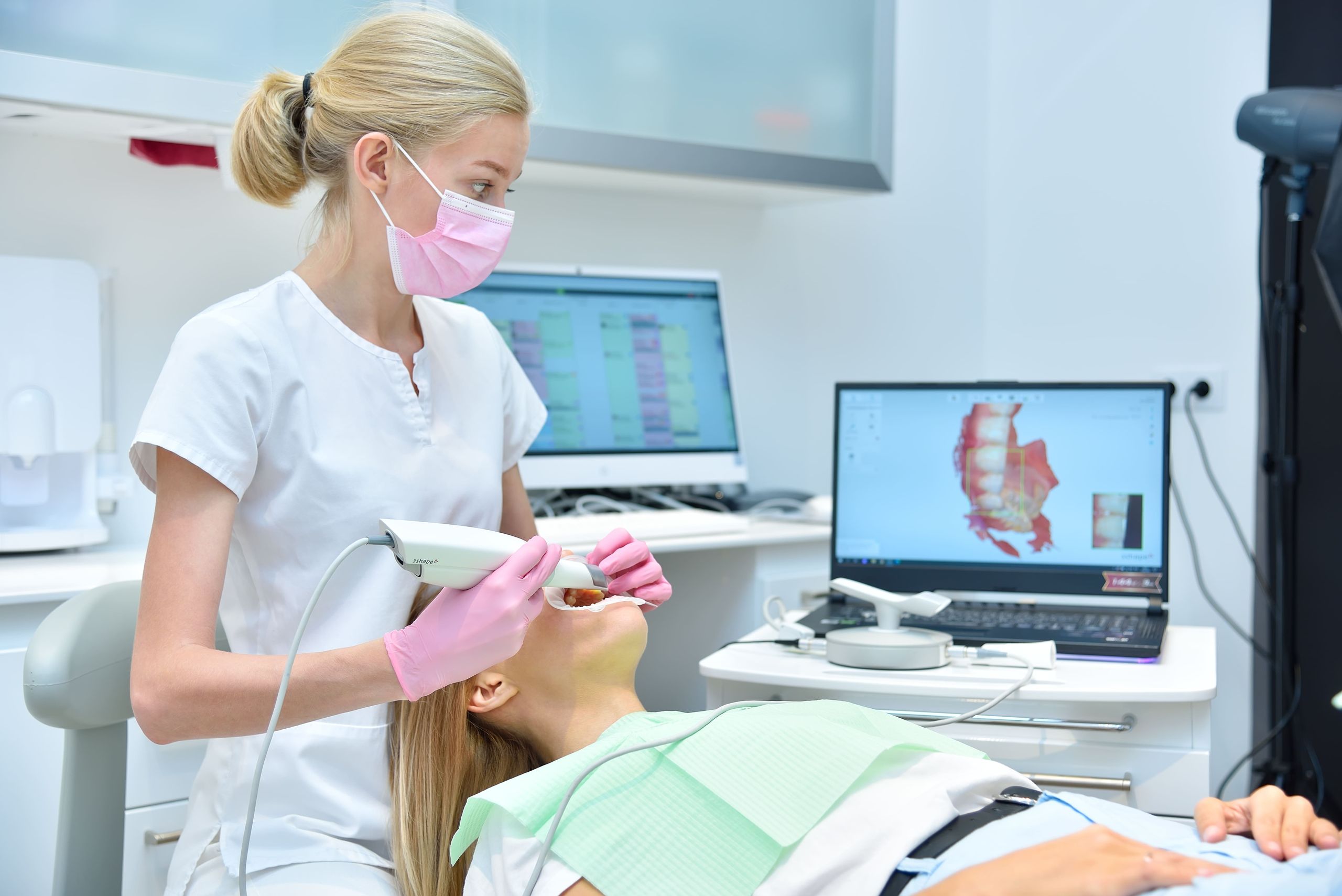Dental software — introduction to digital CAD/CAM technology
What is CAD/CAM dental software?
CAD/CAM dentistry stands for computer aided design and manufacturing of your dental treatment product. It is a vital part of digital dentistry because it is the technology that ensures a doctor can get from treatment plan to execution with the help of software and computers. Dental software as a broad category can consist of not only design and manufacture software, but can for example also refer to imaging software tools, or digital patient management systems. Together, these systems help dental specialists offer patients the most accurate, comfortable, efficient, and beneficial treatment possible. Dental software programs revolutionized dental care by replacing manual administrative and design processes with digital ones 1. Davidowitz G, Kotick PG. The use of CAD/CAM in dentistry. Dent Clin North Am. 2011 Jul;55(3):559-70, ix. doi: 10.1016/j.cden.2011.02.011. PMID: 21726690.. And guess what? The end of the CAD/CAM revolution is not in sight yet.

How does CAD/CAM dental technology work?
In dental clinics, CAD/CAM technology starts with taking an impression of the teeth and gums using either a conventional or a digital impression taking method. If the process starts with a gypsum model, the model first needs to be digitized before work can initiate. Dental laboratories use a dental lab scanner for transforming traditional impressions into digital ones. In some cases, these impression files are combined with cone beam computed tomography (CBCT), also known as X-ray scans, to include additional details in cases where this is required.
Once the dentition is available in digital 3D format, dentists and lab technicians use software to work their magic with digital impressions. With the help of the CAD/CAM software programs, they can construct restorations and appliances, create full dentures, and plan guided surgeries for example.
After the design (the CAD part) is ready, the dental specialist moves on to the manufacturing (CAM) part of CAD/CAM technology. It depends on the type of restoration or appliance whether it will be milled or printed. Some dental software solutions for design are compatible with milling machines and printers so that the product can be printed right away; in other cases, the design needs to be exported so that it can be manufactured by an external production partner.
What are the types of dental software programs?
Dental medical software can be divided into two categories: dental patient management software, which holds patients’ personal information and visit information, and dental treatment software, which is used for documenting and working with the patient’s treatment history and its planning. All programs from the second group can be classified as dental CAD/CAM software. Below, we will describe the most common types of dental software from this group.
Dental design software
This is a form of dental 3d modeling software that helps specialists in clinics and labs design crowns, dentures, bridges, and other restorations 2. Tapie L, Lebon N, Mawussi B, Fron Chabouis H, Duret F, Attal JP. Understanding dental CAD/CAM for restorations--the digital workflow from a mechanical engineering viewpoint. Int J Comput Dent. 2015;18(1):21-44. PMID: 25911827.. These programs for instance help design restorations like crowns and bridges based on a digital impression. The rise of Artificial Intelligence makes these tools quicker and more accurate in the way they can automate the majority of the manual steps, so that only the finishing touch of a crown design needs the hands and eyes of a human expert. Another type of software that is worth mentioning is digital denture software: over the past couple of years, it has been shown possible to fully digitize the process of designing, planning and fabrication of partial and complete dentures. A third category of design software is digital smile design software. This type of software helps patient communication by combining photographs of the patient’s current teeth with a treatment plan, and in this way it can give a realistic visualization of the patient’s future smile, before treatment has even started.

Dental treatment simulation software
This type of dental 3d software is not a design software, but a simulation tool that helps simulate step-by-step outcomes of orthodontic corrections and predict the position of the teeth after for example aligner treatment. In combination with orthodontic planning software, doctors can much more easily communicate about treatment possibilities, outcomes and give patients a step-by-step overview of what is to happen during their treatment. For patients, the transparency in the communication process and around treatment expectations will make treatment acceptance or rejection significantly easier.
Dental patient monitoring software
Software for monitoring enables dentists to see the changes in oral health over time. It is becoming more and more accepted to digitize patient records with the purpose of tracking the patient’s condition, so that the doctor can intervene before serious treatment is needed. This is also called preventative care. Scanning each patient every time can in this way help to detect early caries, tooth wear, grinding, chipping, and other changes invisible to the naked eye. Another benefit of this type of dental treatment software is how it can help educate patients so they get a better understanding of their oral health.
Dental patient engagement software
If you are a dentist and wondering how to improve patient experience in the dental office, then it might be worth implementing patient engagement software into your everyday practice. These solutions help to build stronger relationships with patients by engaging them in the treatment process. Imagine you can show them a before-after comparison. Or send them a treatment plan directly to their smartphones. Dental patient engagement is not only a trend — it’s a new way of communication that is only natural for younger patients. A generation that plays computer games and communicates via apps day-to-day expects this same level of engagement in every part of their lives.
Dental surgery software
Another type of software solution is implant planning software. Dental surgery software Dental surgery software helps doctors perform a prosthetic-driven implant planning workflow by designing the temporary or final restoration and the dental surgical guide software that will assist during implant placement. It can help with either fully guided or partially guided surgery. Plus, it will eliminate guesswork and increase clinician confidence and give predictable outcomes. The software can even generate automated design proposals for the prosthetic designs with the help of Artificial Intelligence. The clinician can edit these based on the patient’s needs and the doctor’s wishes. In this way, software is there to guide the doctor in every step of the process. In some cases, when the clinical situation allows, same-day implant placement is even possible (because the prosthetics can be printed on the spot). Studies showed that computer-guided surgeries help to achieve a better implant survival rate than operations performed without guided solutions 3. Pozzi A, Polizzi G, Moy PK. Guided surgery with tooth-supported templates for single missing teeth: A critical review. Eur J Oral Implantol. 2016;9 Suppl 1:S135-53. PMID: 27314119..
Dental milling software
CAM software for milling is a type of dental clinic or dental laboratory software that is intended for manufacturing bridges, crowns, implant abutments, and other restorations for perfect fitting in the mouth. The milling software either works with imported CAD files and then instructs the mill to create the product in the right way, or alternatively, the design software can communicate with milling machines directly. Dentists can even choose to set up a dental CAD/CAM workflow in-house so they are not as dependent on their lab anymore: they take the digital impression, design the restoration with the dental design software, and produce via milling machines in a single day. This is what is called "same day dentistry" or "chairside dentistry".
What are the benefits of CAD/CAM solutions in dentistry?
Dental software features are mostly revolving around efficiency for both dental specialists and their patients. Below we list the key benefits as acknowledged widely in the industry:
- Cost-efficient. Dental software solutions help digitize a previously physical process, and hence make alginate or other impression material obsolete. This saves material and shipping costs. This reduces treatment cost. In the long term, our ROI Calculator shows that the investment cost of dental software and the hardware that goes with it can pay off in as little as a few months for a doctor.
- Time-saving. Digitizing the design process by means of software allows for treatment in a shorter timeframe and/or fewer visits. Because design and production of devices for dental treatment takes less time, and there is less time spent on the procedures themselves, costs can also be cut. Clinics can even produce restorations in one day in-house, which now allows for complex treatment in a single visit.
- Comfort. Digital impressions allow dentists to replace the annoying alginate impression procedure with a faster, more enjoyable, and easier dental scan with an intraoral scanner.

Dental CAD/CAM academy
Resources
- Davidowitz G, Kotick PG. The use of CAD/CAM in dentistry. Dent Clin North Am. 2011 Jul;55(3):559-70, ix. doi: 10.1016/j.cden.2011.02.011. PMID: 21726690.
- Tapie L, Lebon N, Mawussi B, Fron Chabouis H, Duret F, Attal JP. Understanding dental CAD/CAM for restorations--the digital workflow from a mechanical engineering viewpoint. Int J Comput Dent. 2015;18(1):21-44. PMID: 25911827.
- Pozzi A, Polizzi G, Moy PK. Guided surgery with tooth-supported templates for single missing teeth: A critical review. Eur J Oral Implantol. 2016;9 Suppl 1:S135-53. PMID: 27314119.